How to make Dutch Oven Sourdough Bread
Welcome to the delicious world of homemade Dutch Oven Sourdough Bread! First off, there’s absolutely nothing that quite compares to the delightful crackle of a crusty loaf, the soft, airy interior, and the amazing tangy aroma that fills your kitchen. Baking sourdough bread in a cast iron Dutch oven, an age-old tradition, made from simple ingredients and fermented with natural yeast, sourdough isn’t just a bread, it’s a labor of love.

Save this Recipe for later!
The exterior of a sourdough loaf boasts a beautiful, golden crust that’s delightfully crispy, providing an audible crunch with every bite. The interior, or crumb, is soft and chewy, dotted with characteristic air pockets that vary in size. It holds a complex flavor profile, perfectly balanced between mild tanginess and a subtle, inherent sweetness from the grains.
What is Dutch Oven Sourdough Bread?
Sourdough bread is the end product of an age-old technique that uses natural yeast and bacteria to make bread rise. The Dutch oven, with its superb heat retention and circulation, ensures your loaf bakes evenly and achieves that picture-perfect, artisan crust. The result? A rustic, beautifully browned sourdough loaf that’s sure to rival the most amazing bread.

What you’ll love about this recipe:

Ingredients you’ll need for this amazing sourdough bread:
- active sourdough starter- nice and bubbly!
- warm water- not too hot or it will kill the yeast, just warm like you’d bath a baby in
- salt- sea salt, or regular will do
- flour- I prefer to use bread flour

Step-by-step Instructions for this homemade sourdough bread:
- Prepare the Dough: To start off, take a large mixing bowl and combine the active sourdough starter, warm water, and salt. Following this, stir the mixture until the point where the salt completely dissolves.
- Add the Flour: Gradually add the bread flour to the bowl. Stir with a wooden spoon or a dough whisk until the mixture comes together into a shaggy dough.
- Knead the Dough: Turn the dough out onto a lightly floured surface. Begin kneading the dough by pushing it away with the heel of your hand and folding it back towards you. Continue kneading for about 10 minutes until the dough becomes smooth and elastic.
- First Rise: Place the kneaded dough back into the mixing bowl. Cover the bowl with a damp cloth or plastic wrap and let it rise at room temperature for about 4-6 hours. The dough should roughly double in size.
- Shape the Loaf: Once the dough has risen, gently turn it out onto a lightly floured surface. Shape it into a round shape. Place the shaped dough into a banneton bread basket that has been generously dusted with flour, or lined with parchment paper.
- Second Rise: Cover the dough loosely with a clean kitchen towel and let it rise for another 2-3 hours at room temperature. The dough will puff up slightly and take on the shape of the banneton.
- Preheat the Oven: About 30 minutes before baking, preheat your oven to 450°F. Place a Dutch oven with a tight fitting lid on, inside the oven as it preheats.
- Score and Bake: Once the oven is fully preheated, carefully remove the hot Dutch oven. Turn the dough out onto a piece of parchment paper, scored side up. Transfer the parchment paper with the dough into the preheated Dutch oven. Cover it with the lid and place it back in the oven.
- Bake with Lid: Bake the bread covered for 20 minutes. Having the lid on will create steam, which helps the bread rise and develop a crispy crust.
- Bake without Lid: Following the initial 20-minute baking period, it’s time to take the lid off the Dutch oven. Proceed then with the baking process for an additional span of 20-25 minutes. This subsequent baking period should continue until the bread exhibits a golden brown hue and emits a hollow sound when tapped on the bottom, indicating that it’s perfectly baked.
- Cool and Enjoy: Once the bread is done baking, you’ll want to carefully lift it out of the Dutch oven. Then, place it on a wire rack to cool down. You’ll need to wait at least an hour before you start slicing. It gives the bread time to set and makes it easier to cut. Good things come to those who wait!
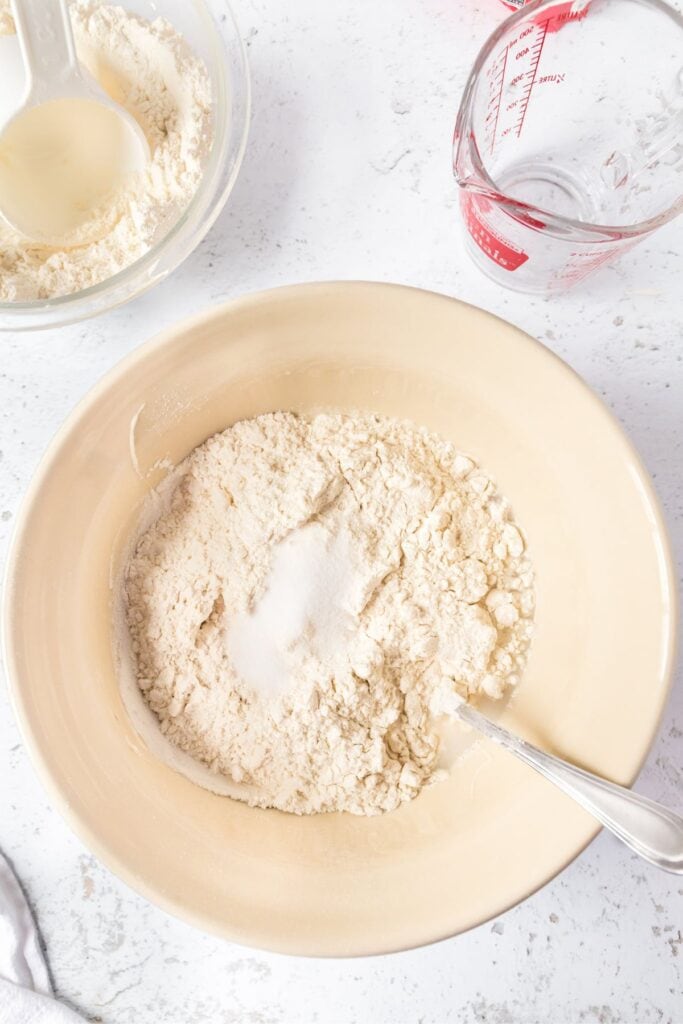

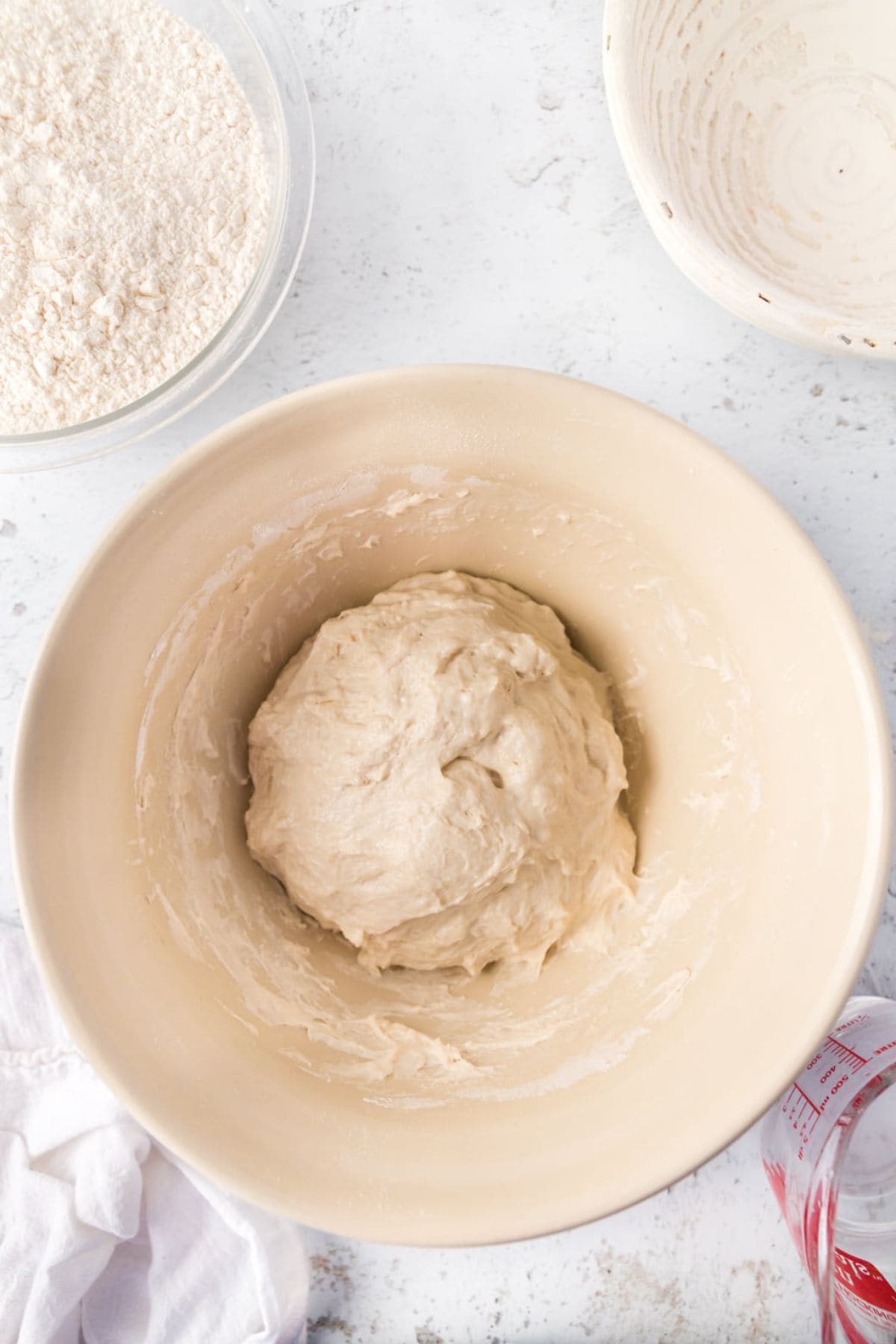
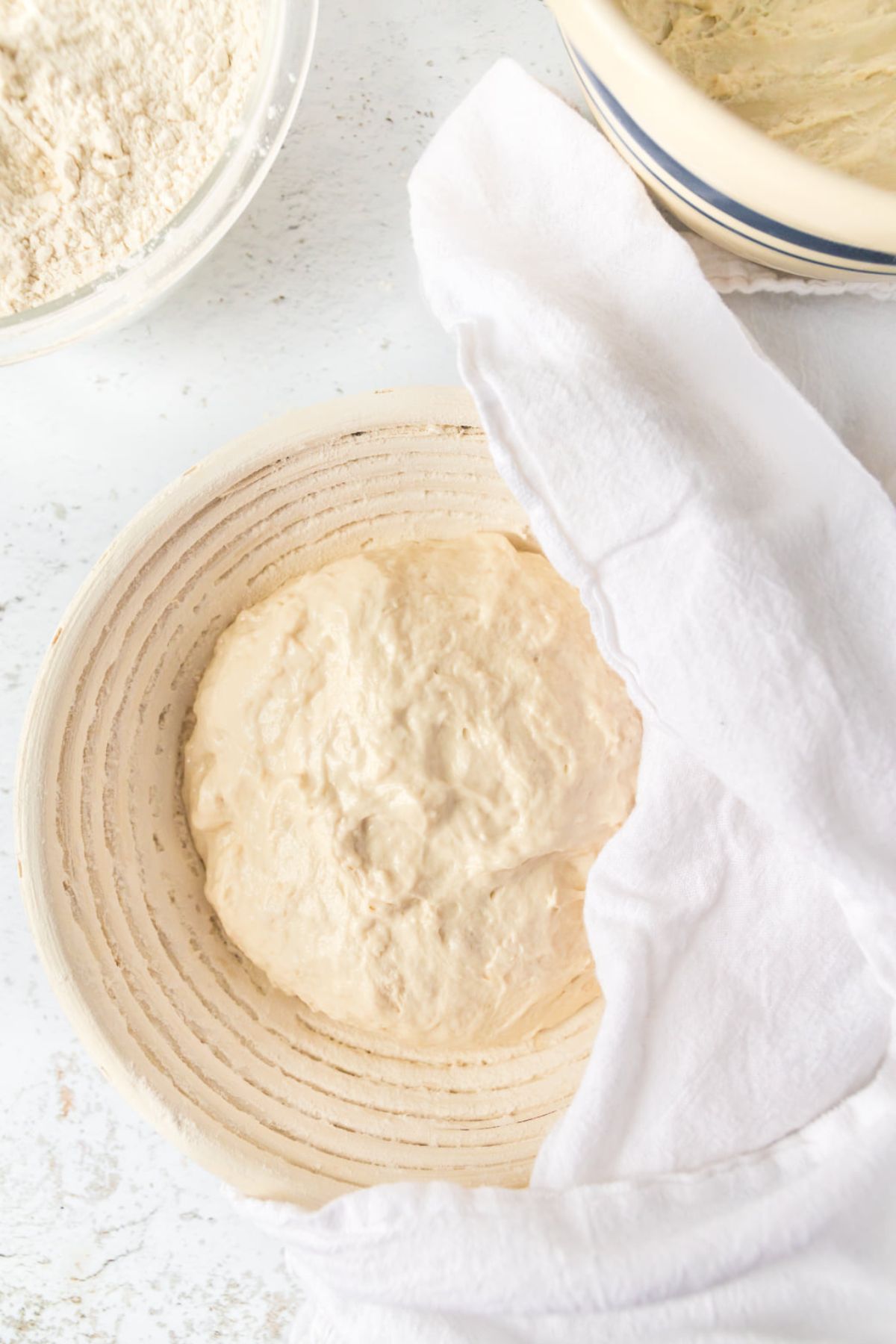
Want a pretty decorated loaf?
I love to use a Banneton bread proofing basket. The banneton basket has a woven structure that creates a pattern of ridges and flour-dusted indentations on the surface of the dough. These ridges help to create a beautiful spiral pattern on the crust of the bread as it bakes.
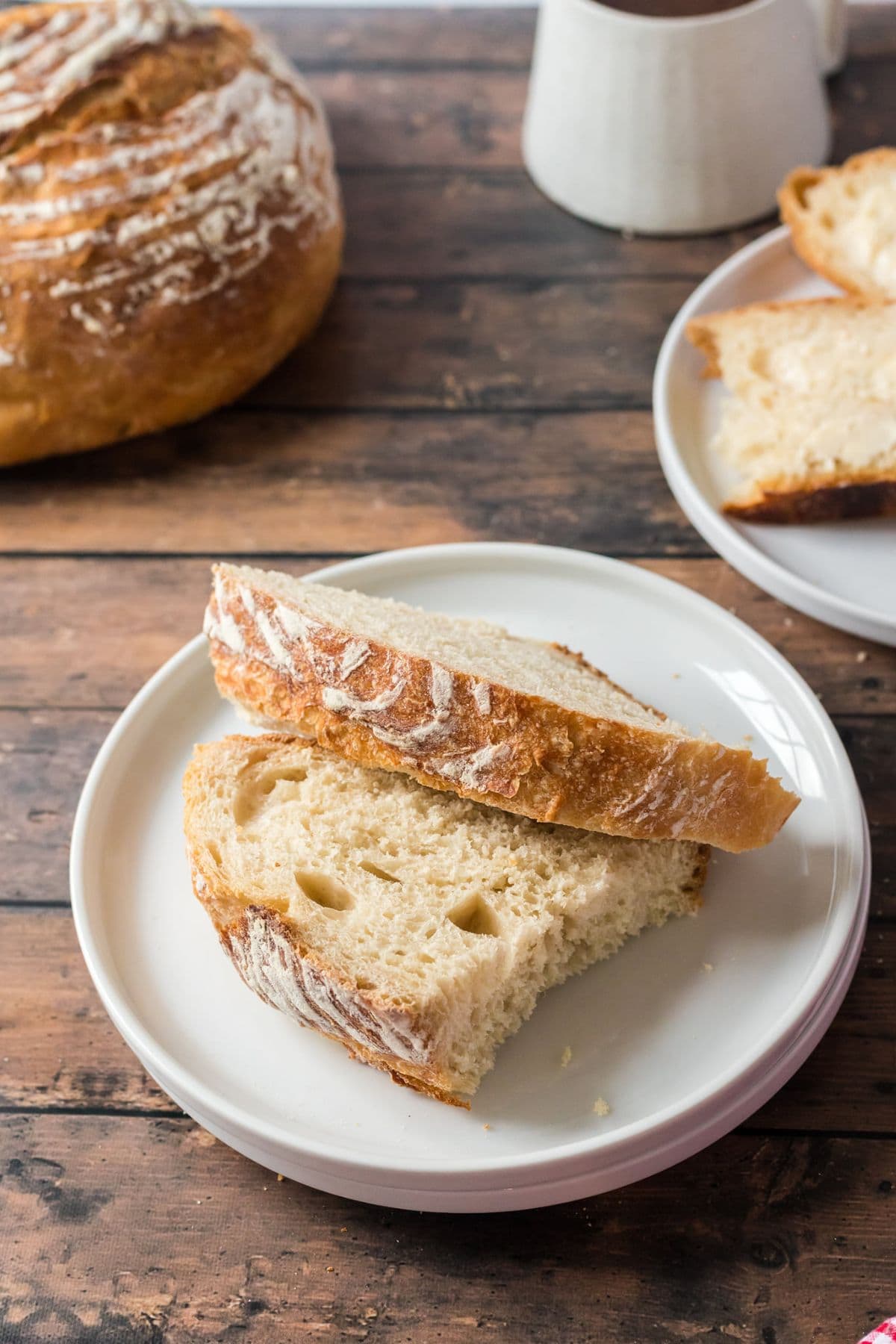
Get my FREE Meal Planning Guide
I give you my Top 5 Meal Planning tips to help you streamline your dinner menu, making mealtime organization a breeze!
EXPERT TIPS
- Starter Health: A healthy, active starter is key to good sourdough bread. Continuously maintain your starter by feeding it regularly. More importantly, ensure it’s active and full of bubbles prior to incorporating it into your dough.
- Hydration Levels: Hydration levels can greatly influence the outcome of your bread. The higher the hydration, the more open the crumb will be, however, a high hydration dough can be harder to handle. For beginners, a hydration level of around 65%-70% is a good starting point.
- Proper Kneading: Kneading helps develop gluten in the dough, which is crucial for the structure of the bread. Make sure to knead your dough thoroughly, until it becomes smooth and elastic.
- Bulk Fermentation: Be patient during this step. The dough should be allowed to rise until it is visibly puffy and has roughly doubled in size. This can take anywhere from 3 to 12 hours, depending on the temperature and the strength of your starter.
- Shaping the Loaf: Shape the dough firmly but gently to maintain as much of the air and structure as possible. The tighter the shape, the higher the loaf will rise.
- Score the Loaf: Right before you place the dough in the oven, score the top of the dough with a bread lame or sharp knife. This allows the bread to expand freely in the oven. I like to do 3 cuts with a bread lame, my knives usually deflate the dough.
- Preheat the Dutch Oven: Preheating the Dutch oven before placing your dough inside is crucial to achieving a crispy crust. The high heat helps the bread rise rapidly and the enclosed space traps steam from the dough, creating a crispy crust.
- Cool Before Slicing: As tempting as it might be to cut into your fresh loaf straight out of the oven, let it cool completely before slicing. This allows the crumb to set and the flavors to develop fully.
- Practice Makes Perfect: Don’t get discouraged if your first few loaves aren’t perfect. Sourdough is as much of an art as it is a science. So just keep practicing, and learning, and you’ll be making loaves that not only look great, but taste amazing too. Happy baking!

Meet Hermie…
I created my 1st sourdough starter 20+ years ago, it was from a recipe called Herman. So ever since then I’ve always called my sourdough starters the same name. Throughout the years the name has been shortened to “Hermie” . I’ve discovered this is common amongst Sourdough aficionados. I would love to know what you nicknamed your starter, please share in the comments below.
FREQUENTLY ASKED QUESTIONS ABOUT THIS EASY SOURDOUGH BREAD:
How do I know when my sourdough bread is done baking?
The sourdough bread is done when it has a dark, golden-brown crust and sounds hollow when tapped on the bottom. A thermometer inserted into the center should read between 190°F and 210°F. I love using an instant read thermometer that allows me to monitor the temperature of the bread without compromising its appearance, which means no holes or tears in the bread.
Why is my sourdough bread dense?
Your bread may turn out dense due to a few reasons. Initially, under-proofing could be a significant factor., insufficient kneading may contribute to this issue. Moreover, not providing enough heat during baking can also lead to denseness. Therefore, in order to tackle these problems, it’s crucial to take a few steps. Primarily, ensure that you allow your dough to rise fully during the bulk fermentation stage. Following this, the dough should also be well-proofed. Secondly, it’s vital to develop the gluten properly through thorou
My sourdough isn’t rising. What did I do wrong?
There could be a few reasons for this. The most common is that your starter wasn’t active enough. Make sure to feed your starter regularly and use it at its peak activity. Other factors could be the temperature of your kitchen, the freshness of your flour, or the amount of salt in the recipe.
Why is my sourdough bread too sour?
The sourness of sourdough bread can be influenced by several factors, including the length of fermentation, the temperature at which you ferment your dough, and the hydration level of your starter. To reduce sourness, try shortening the fermentation time or lowering the fermentation temperature. If you need to let it rise a super long time, just place it in the fridge and let it slow rise in there.
Can I make sourdough bread without a Dutch oven?
Yes, you have the option to bake sourdough bread on a baking stone or a baking sheet. However, utilizing a Dutch oven offers distinct advantages. First and foremost, it creates a steamy environment that results in a crispy crust, elevating the overall texture of the bread. Moreover, it promotes superior oven spring, giving your loaf that desired height and lightness. In case you don’t have a Dutch oven, fret not! You can still achieve a similar effect by placing a pan of water on the bottom rack of your oven. This will help create the necessary moisture and steam for a successful bake.
SUBSTITUTIONS & ADDITIONS:
Substitutions:
- Flour: When it comes to sourdough bread, bread flour is the go-to choice due to its high protein content. However, if you find yourself in a pinch, feel free to substitute it with all-purpose flour.
- Water: You can replace a part of the water with milk for a different flavor, however, milk can produce a softer crust. So please note this if you prefer a crunchy crust.
- Salt: Although I like to use sea salt in my sourdough recipes, but you can use any salt you have on hand.
Additions:
- Seeds and Nuts: Add some extra flavor and texture to your sourdough bread by incorporating seeds or nuts into your dough. Sesame seeds, pumpkin seeds, sunflower seeds, flax seeds, walnuts, and pecans are all great options.
- Dried Fruits: If you like a bit of sweetness in your bread, consider adding dried fruits like raisins, cranberries, apricots, or figs.
- Herbs and Spices: To take your bread to the next level, consider adding fresh or dried herbs like rosemary, thyme, or oregano. These aromatic additions can bring a delightful aroma and flavor to your loaf.
- Cheese: Bits of cheese scattered throughout the dough can create delicious pockets of flavor. Consider options like sharp cheddar, gouda, or my personal favorite-feta.
SERVING SUGGESTIONS:
- Big Chunks: Our most favorite way to eat bread is just to tear it off in big chunks! Perfect for sopping up any liquid, or using it as a dip for soups or dips.
- Toasted: There’s nothing quite like a slice of freshly toasted sourdough bread spread with just butter. The warmth intensifies the bread’s flavors, and the butter adds a delightful richness. Or add some jelly or jam on top of the butter and you’re in hog heaven!
- Sandwiches: The sturdy, chewy texture of sourdough makes it an excellent choice for sandwiches. It holds up well to a variety of fillings, from classic ham and cheese to vegetable-loaded options.
- French Toast: Elevate your French toast game by using sourdough. Its tangy flavor adds a new dimension to this beloved breakfast dish.
- Bread Bowl: Carve out the inside of a small sourdough loaf and fill it with a hearty soup or a creamy dip. The round shape makes it the perfect bread bowl!It’s a fun and delicious serving option for parties.
- Bruschetta: Toast slices of sourdough and top them with a mixture of chopped tomatoes, basil, garlic, and olive oil for a simple and tasty appetizer.
- Croutons: Homemade Sourdough croutons add a satisfying crunch to salads or soups. Also, another option is to blend them into breadcrumbs.

Dutch Oven Sourdough Recipe
Ingredients
- 3/4 cup Active Sourdough Starter
- 1 1/4 cups Warm Water
- 1 teaspoon Salt
- 3 1/2 cups Bread Flour
Instructions
- In a large mixing bowl, combine the active sourdough starter, warm water, and salt. Stir until the salt is dissolved.
- Gradually add the bread flour to the bowl. Stir with a wooden spoon, fork, or a dough whisk until the mixture comes together into a shaggy dough.
- Turn the dough out onto a lightly floured surface. Begin kneading the dough by pushing it away with the heel of your hand and folding it back towards you. Continue kneading for about 10 minutes until the dough becomes smooth and elastic.
- First Rise: Place the kneaded dough back into the mixing bowl. Cover the bowl with a damp cloth or plastic wrap and let it rise at room temperature for about 5-6 hours. The dough should roughly double in size.
- Once the dough has risen, gently turn it out onto a lightly floured surface. Shape it into a round shape. Place the shaped dough into a banneton bread basket that has been generously dusted with flour, or lined with parchment paper.
- Second Rise: Cover the shaped dough loosely with a clean kitchen towel and let it rise for another 2-3 hours at room temperature. The dough will puff up slightly.
- About 30 minutes before baking, pre-heat your oven to 450°F. Place the Dutch oven with its lid on, inside the oven as it pre-heats.
- Once the oven is fully preheated, carefully remove the hot Dutch oven. Turn the dough out onto a piece of parchment paper, scored side up. Transfer the parchment paper with the dough into the preheated Dutch oven. Cover it with the lid and place it back in the oven.
- Bake the bread covered for 20 minutes. The lid will create steam, which helps the bread rise and develop a crispy crust.
- After 20 minutes, remove the lid from the Dutch oven and continue baking for an additional 20-25 minutes, or until the bread is golden brown and sounds hollow when tapped on the bottom.
- Once baked, carefully remove the bread from the Dutch oven and place it on a wire rack to cool completely. Allow the bread to cool for at least 1 hour before slicing.
Looking for more Bread Recipes? Check out our favorites:
Don’t be scared of sourdough bread, just do it!
Afterwards, you’ll be so proud of yourself for baking a glorious loaf of Sourdough Bread. Don’t worry if it’s not perfect right the first time, each loaf is a learning experience. The more you bake, the better you’ll get to know the feel and timing of the dough. Before you know it, you’ll be a Sourdough Superstar!
Did you make this recipe?
If you loved this recipe, please leave a Review! Don’t forget to tag us on Instagram at @littlechefwithin, and also use #littlechefwithin. We love seeing your creations!


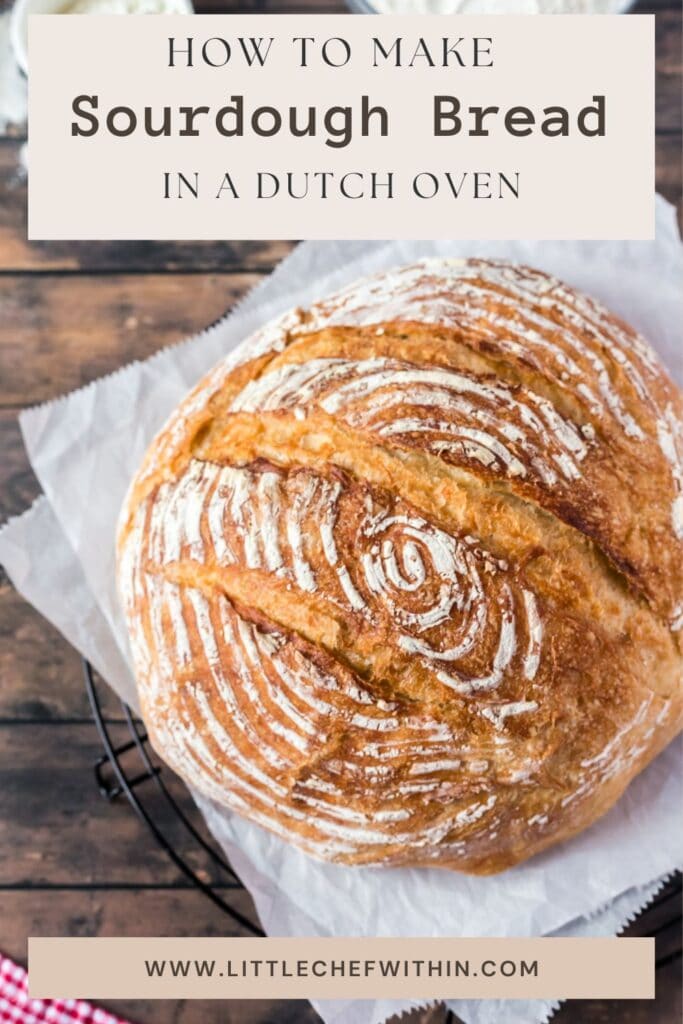
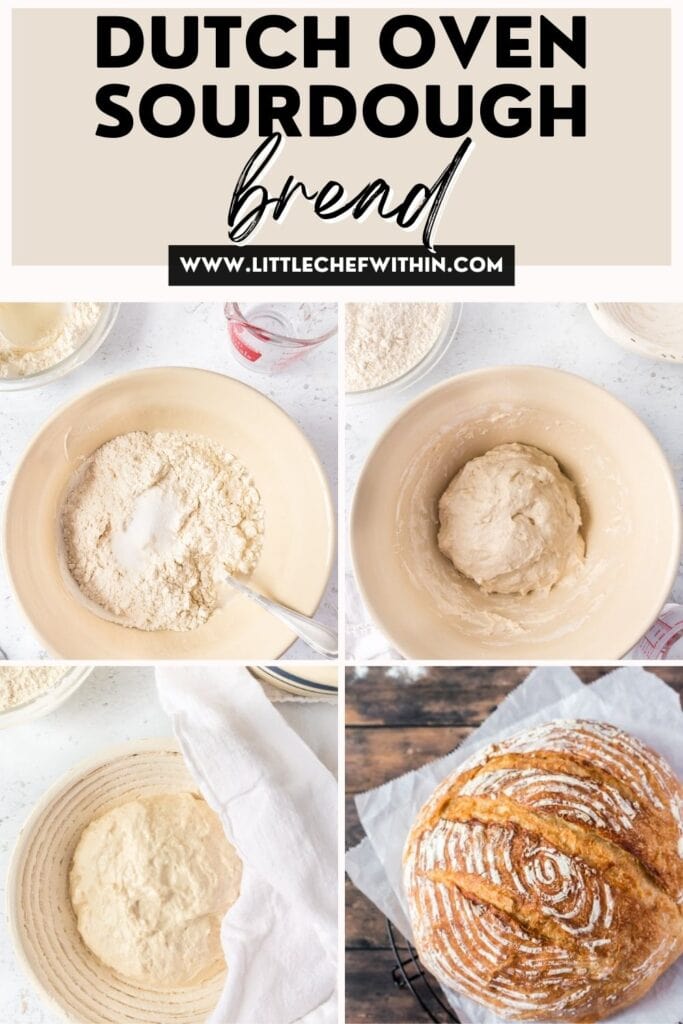
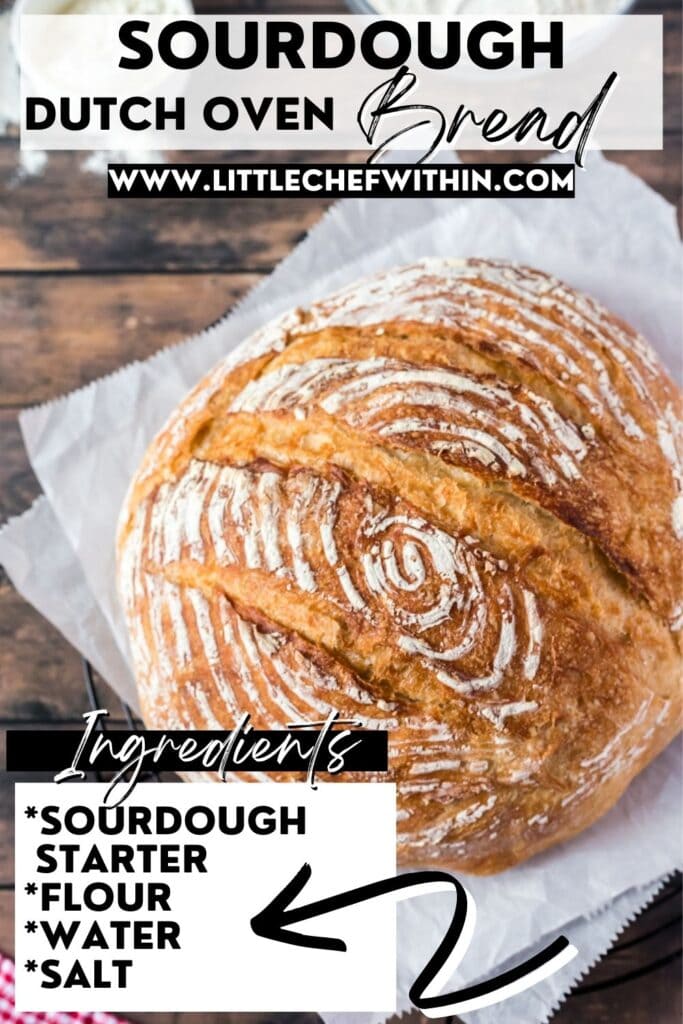
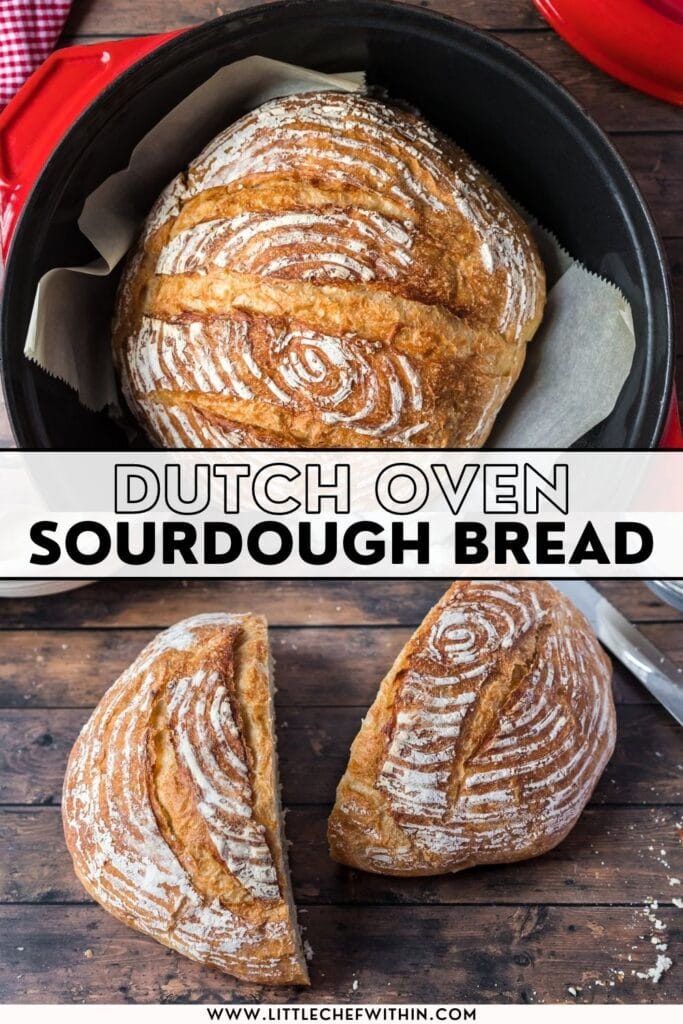






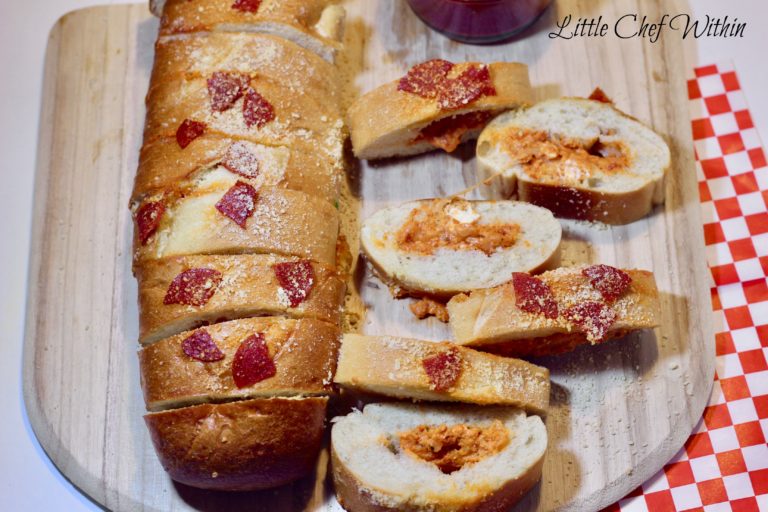
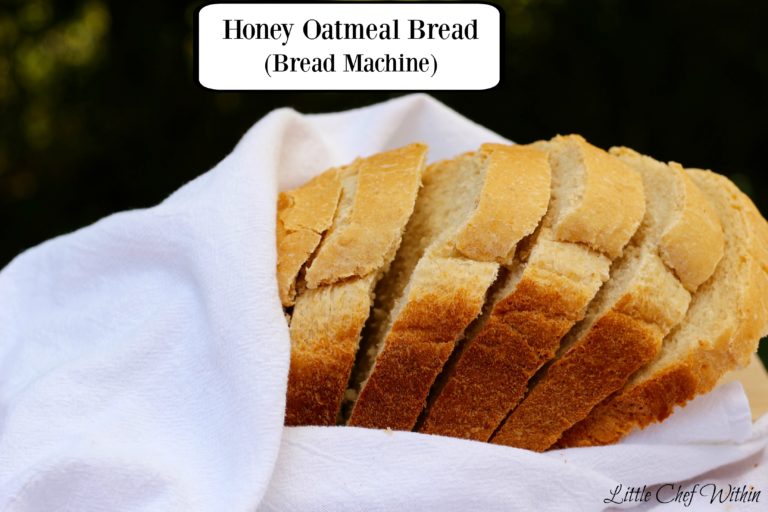







I am trying to perfect baking bread. This is one thing that I just can’t seem to get just right. I am going to give this recipe a try this weekend! Thank you!
I hope it works for you, we love it!!
These are wonderful instructions on how to make homemade Dutch Oven Sourdough Bread. I’ve never tried making it, but it looks so yummy I’m inspired to try!
You should try it!!
Thank you giving suggestions on what to do with leftover bread! Can’t wait to try!
Hope you enjoy the recipe!
I’ve never tried to make sour dough, but this is inspiring. I just might give it a try!
You really should, you may love it!!
I have a 150 year old starter from California and once I started making sourdough bread I found that I cannot go back to store bought bread. Great information on this post.
Oh wow! You should package that and sell it! I’m sure it’d be super popular!!
Love this! Always been too nervous to try making bread but this recipe sounds great. Thank you
You should try it sometime, this one is easy!
I could easily eat the whole loaf on my own!
Bread is sooo good!!
I am a horrible baker but this looks so yummy, I may try again 🙂
Yes! Give it a try again!
Thank you for sharing this easy to make recipe. Sourdough sounds delicious.
Pastor Natalie (ExamineThisMoment)
Letstakeamoment.com
Sourdough is so delicious, we love it!